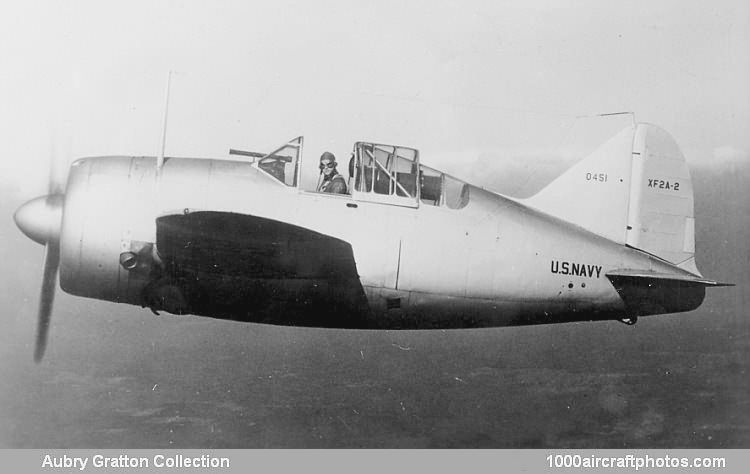07/31/2016. Remarks by Johan Visschedijk: "In 1936, Dayton T. Brown and R. D. MacCart of the Brewster Aeronautical Corporation began the design of the Model B-139, an all-metal single-seat shipboard fighter monoplane with an unusual retractable landing gear (originally designed for the Boeing 278A fighter project of 1934). Under the BuNo. 0451 and designated XF2A-1, the USN ordered a prototype on June 22, 1936. Powered by a Wright XR-1820-22 Cyclone engine rated at 950 hp for take off, the XF2A-1 first flew eighteen months later, in December 1937.
On June 11, 1938, an order was placed by the USN for 54 examples of a developed version powered by an R-1820-34 offering 940 hp for take off and carrying an armament of twin 0.5 in (12.7 mm) Colt machine guns in the wings and one 0.5 in (12.7 mm) and one 0.3 in (7.62 mm) gun in the fuselage. Deliveries of this model, the B-239 (F2A-1), to the US Navy began in June 1939, only eleven entering service (as the USN's first fighter monoplanes), the remaining 43 being declared surplus to requirements and released for export to Finland. In Finnish AF service, the B-239 fighters eventually had the single 0.3 in (7.62 mm) weapon replaced by a fourth 0.5 in (12.7 mm) gun, and remained in the first-line inventory for more than eight years, the last flight of a Finnish B-239 taking place on 14 September 1948.
On March 22, 1939, the USN ordered the installation of a Wright R-1820-40 engine in the XF2A-1, this offering 1,200 hp for take off and 900 hp at 14,000 ft (4,267 m). An electric propeller supplanted the original hydraulic propeller, the fuel tank was redesigned for a high pressure carburetor system, and various other changes were introduced, the prototype being redesignated XF2A-2. Trials with the XF2A-2 began in July 1939, and 43 examples of the improved version were ordered as F2A-2s in lieu of the same number of F2A-1s released for export to Finland. USN acceptances of the F2A-2 began in September 1940, armament initially being similar to that of the F2A-1, but the 30th F2A-2 standardized on a quartet of 0.5 in (12.7 mm) Colt machine guns, introducing at the same time some armor and a protected fuel tank."
